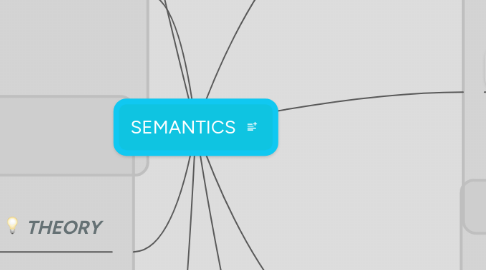
1. The meanings of words and sentences in a language...
1.1. Can be safely taken as known to competent speakers.
1.2. Native speakers of language
1.2.1. The primary source of information about the meaning.
1.3. The student (or the professor) of semantics...
1.3.1. May will be good at describing meanings.
1.3.2. Theorizing about meaning in general.
1.3.3. But he has no advantage over any normal speaker of a language.
2. The study of meaning in language
2.1. SPEAKER MEANING
2.1.1. Is what a speaker means.
2.1.1.1. When he uses a piece of language.
2.2. SENTENCE MEANING
2.2.1. Is what a sentence or word means.
2.2.1.1. For example
2.2.1.1.1. What it counts as the equivalent of in the language concerned.
3. THEORY
3.1. It is a precisely...
3.1.1. Specified
3.1.2. Coherent
3.1.2.1. Framework of interdependent statements and definitions.
3.1.2.1.1. Constructed so that as a large a number as possible of particular basic facts.
3.1.3. Economical
4. SENTENCE
4.1. Is neither...
4.1.1. A physical event.
4.1.2. A physical object.
4.2. is a grammatically complete string of words.
4.2.1. Expressing.
4.2.1.1. A complete thoughtful
4.3. Is conceived abstractly...
4.3.1. A string of words.
4.3.1.1. Put together.
4.3.1.1.1. By the grammatical rules of a language.
4.4. Can be thought of...
4.4.1. As the IDEAL string of words.
4.4.1.1. Behind
4.4.1.1.1. Various realizations in...
5. UTTERANCE
5.1. Is any stretch of talk.
5.1.1. By one person.
5.1.1.1. Before and after which there is a silence.
5.1.1.1.1. On the part of that person.
5.2. Is the USE...
5.2.1. By a particular speaker.
5.2.2. On a particular ocassion.
5.2.2.1. Such as...
5.2.2.1.1. A sequence of sentences.
5.2.2.1.2. A single phrase.
5.2.2.1.3. Even a single word.
5.2.3. Of a piece of language.
6. PROPOSITION
6.1. Is that part of the meaning...
6.1.1. of the utterance...
6.1.1.1. of a declarative sentence...
6.1.1.1.1. which describes some state of affairs.
6.2. One can entertain propositions in the mind...
6.2.1. regardless of whether they are...
6.2.1.1. True
6.2.1.1.1. Only true propositions can be known.
6.2.1.2. False
7. REFERENCE
7.1. A speaker indicates which things in the world...
7.1.1. (Including people)
7.1.1.1. are being talked about.
7.2. For example.
7.2.1. "My son is in the bench tree".
7.2.1.1. Identifies the person.
7.2.1.2. Identifies the thing/object.
7.3. There are cases of expressions which in normal everyday conversation never refer...
7.3.1. to diferent things.
7.3.1.1. For example...
7.3.1.1.1. In most everyday situations that one can envisage...
8. SENSE
8.1. Is its place in a system of...
8.1.1. Semantic relationships
8.1.1.1. with other expressions...
8.1.1.1.1. In the language.
8.2. On the relationship with REFERENCE...
8.2.1. The referent of an expression is...
8.2.1.1. Often a thing or a person in the world.
8.2.1.1.1. Whereas the sense of an expression...

